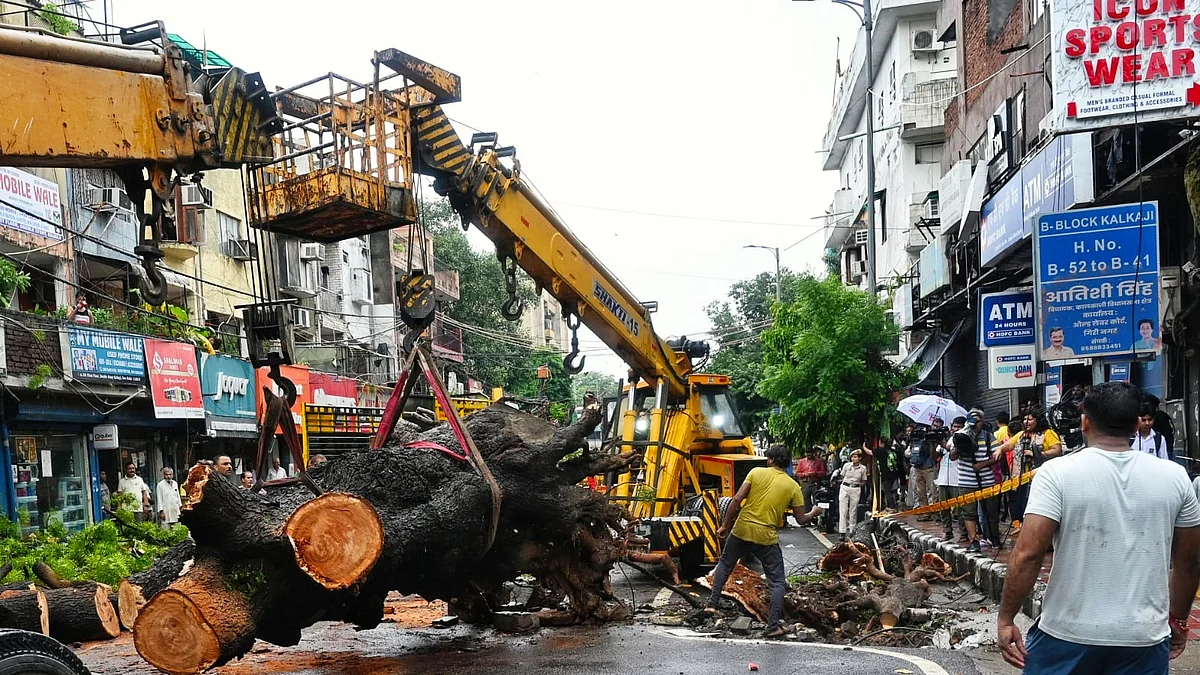When life-giving trees turn deadly
Poor urban planning, unchecked pollution and neglect are turning Delhi’s century-old green cover into a public hazard

On the eve of Independence Day, during heavy rain in South Delhi’s Kalkaji, a 50-year-old man sought shelter beneath a neem tree. Tragically, the more than 20-year-old tree was uprooted and fell, killing the man instantly. His daughter, who was with him on a motorcycle, is now in hospital fighting for her life.
CCTV footage shows the tree collapsing onto unsuspecting commuters. It also crushed several vehicles, including the motorcycle carrying the father and daughter. Local residents explained that continuous rainfall had eroded the soil around the tree, weakening its hold and causing it to topple.
As so often happens, the Municipal Corporation of Delhi (MCD) has repeated the call to identify and prune weak trees. Yet, no serious study has ever been undertaken to understand why trees planted on dividers or pavements are so easily uprooted after a spell of rain in Delhi and its neighbouring cities. Not every falling tree causes fatalities, but they do frequently bring traffic to a standstill for hours. Even central Delhi, once thought to be relatively safe, is no longer spared.
The very trees that once symbolised shelter and life are now turning into silent hazards, toppled by neglect and poor urban planning
It is worth recalling that on 14 February 2022, Delhi High Court directed all municipal corporations and relevant agencies — including the DDA (Delhi Development Authority) and PWD — to establish “tree ambulances” to protect and preserve the city’s greenery. The court stressed that experts should be engaged for this work.
A year later, some such ambulances did appear on the roads. Yet, judging by incidents like the one in Kalkaji and others elsewhere in the city, it is clear that the initiative has barely progressed beyond token publicity.
Delhi has long been considered fortunate for its green cover. When the city was established as the capital, British architect Sir Edwin Lutyens oversaw the planting of distinctive trees along each road. These included long-lived species such as jamun, tamarind and neem. They offered shade and beauty but also served as markers for residents — for example, Ashok Road was once identified by its jamun trees.
Most of these trees were planted between 1910 and 1930, meaning they are now over a century old. Their age alone does not make them fragile, but decades of poor planning have denied them the space and soil depth needed for healthy root systems. Cemented pavements and bitumen roads restrict root spread, while erosion and waterlogging further weaken their grip, leaving them vulnerable even in light rain or storms.
Major incidents of trees falling in Delhi (2025)
2 May – A family suffered serious loss when a tree collapsed in Jafarpur Kalan
21 May – Several trees were uprooted by storms and heavy rain across Delhi-NCR, disrupting traffic and metro services.
15 June – A tree fell in R.K. Puram, snapping live wires and killing two workers
14 August – A large tree collapsed during heavy rain in Kalkaji, killing a motorcyclist and injuring another
We must accept that the relentless use of cement, tiles and asphalt in the name of urban beautification is suffocating the very greenery we claim to preserve. Large trees require deep, spreading root systems and a reliable supply of water and nutrients. In forests, fallen leaves decompose into compost, nourishing the soil and sustaining the trees.
In Delhi and other big cities, however, roots are forced to remain shallow because the deeper soil is starved of water. Most rainfall is diverted into drains rather than allowed to seep into the ground. With nearly every surface sealed by concrete, tiles or bitumen, roots are unable to anchor the trees firmly.
Air pollution adds to this crisis. The Air Quality Expert Group (UK), in its 2018 report 'Effects of Vegetation on Urban Air Pollution', observed that traffic-related pollution can slow tree growth, damage leaves and make them more vulnerable to disease and pests.
Ozone interferes with photosynthesis, while airborne chemicals seep into the soil, weakening root systems. Acid rain, produced when sulphur dioxide and nitrogen oxides react with atmospheric moisture, depletes the soil of essential nutrients like calcium and magnesium, leaving trees fragile and disease-prone. Termite infestation has already taken a heavy toll on many trees in Delhi.
Protecting trees from pollution is as vital as protecting humans — regular watering, along with appropriate treatments, could help sustain their health. If the causes of weakening are properly studied, solutions will follow naturally.
Urban planning must take into account the needs of trees: the soil around their roots should be kept permeable and moist during the construction of roads, pavements and parking areas. Unless this is addressed, the very trees that once symbolised shelter and life will continue to pose a deadly threat to the citizens they were meant to protect.
Follow us on: Facebook, Twitter, Google News, Instagram
Join our official telegram channel (@nationalherald) and stay updated with the latest headlines
